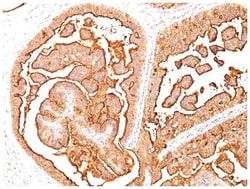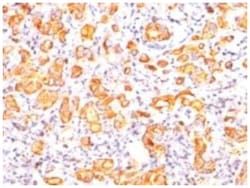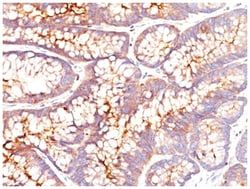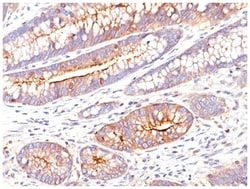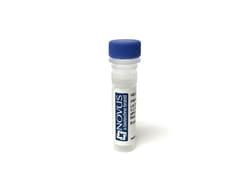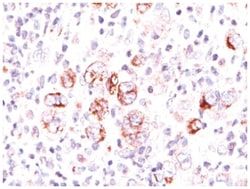alpha-Methylacyl-CoA Racemase/AMACR Antibody, Novus Biologicals™
Rabbit Polyclonal Antibody
Manufacturer: Fischer Scientific
The price for this product is unavailable. Please request a quote
Antigen
alpha-Methylacyl-CoA Racemase/AMACR
Applications
Western Blot, Immunohistochemistry (Paraffin)
Conjugate
Unconjugated
Host Species
Rabbit
Research Discipline
Lipid and Metabolism, Prostate Cancer, Signal Transduction
Formulation
PBS with 0.05% BSA. with 0.05% Sodium Azide
Gene Alias
2-methylacyl-CoA racemase, alpha-methylacyl-CoA racemase, CBAS4, EC 5.1.99.4, RACE, RM
Gene Symbols
AMACR
Isotype
IgG
Purification Method
Protein A purified
Test Specificity
This antibody recognizes a protein of 54kDa, which is identified as AMACR, also known as p504S. It is an enzyme that is involved in bile acid biosynthesis and oxidation of branched-chain fatty acids. AMACR is essential in lipid metabolism. It is expressed in cells of premalignant high-grade prostatic intraepithelial neoplasia (HGPIN) and prostate adenocarcinoma. The majority of the carcinoma cells show a distinct granular cytoplasmic staining reaction. AMACR is present at low or undetectable levels in glandular epithelial cells of normal prostate and benign prostatic hyperplasia. A spotty granular cytoplasmic staining is seen in a few cells of the benign glands. AMACR is expressed in normal liver (hepatocytes), kidney (tubular epithelial cells) and gall bladder (epithelial cells). Expression has also been found in lung (bronchial epithelial cells) and colon (colonic surface epithelium). AMACR expression can also be found in hepatocellular carcinoma and kidney carcinoma. Past studies ha
Dilution
Western Blot 1:100-1:200, Immunohistochemistry-Paraffin 1:50-1:100
Classification
Polyclonal
Form
Purified
Regulatory Status
RUO
Target Species
Human
Gene Accession No.
Q9UHK6
Gene ID (Entrez)
23600
Immunogen
A synthetic peptide from human AMACR protein
Primary or Secondary
Primary
Content And Storage
Store at 4C.
Molecular Weight of Antigen
54 kDa
Description
- alpha-Methylacyl-CoA Racemase/AMACR Polyclonal specifically detects alpha-Methylacyl-CoA Racemase/AMACR in Human samples
- It is validated for Western Blot, Immunohistochemistry, Immunohistochemistry-Paraffin.

